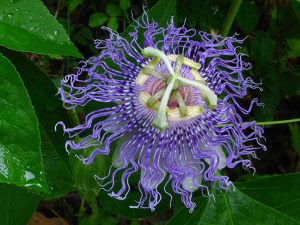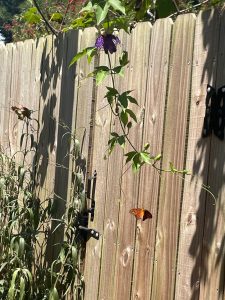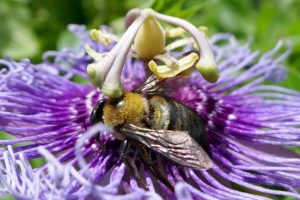
There are some things in nature that look so bizarre, so beautiful, or so ornate that one can scarcely believe they’re real. This was how I felt the first time I looked closely at a passionflower (Passiflora incarnata) bloom. Between the deep shade of purple, the squiggly intricate filaments of the “corona” above the petals, and the bright green stigma and ovary, it seemed like something from the imagination of Dr. Seuss.

Our vine is full of blooms right now, and every time I walk past the arbor I stop in admiration. I’m not the only one—the plant is covered up with Gulf fritillary butterflies, small orange and black near-mimics of monarchs. Like the monarch, they possess chemical defense mechanisms that make them taste bad to would-be predators. Fritillaries are so fond of passionvines as a nectar source that they are sometimes referred to as “passion butterflies.” Adult females frequently lay their eggs on the plant, as well.

Carpenter bees are big fans of the flower, digging for pollen throughout its bloom time. The leaves also attract pollinator insects; they have “extrafloral nectaries” that secrete a sugary substance at their bases, attracting bees and ants.
Passionfruit are quite large for such a delicate vine—spherical, green, and about the size of a chicken egg. The plant is also known as a “maypop.” I’ve seen two explanations for this; the fruit’s skin is fairly thin, so it will respond with a satisfying “pop” if stepped on. Alternatively, the name could come from the idea that if the fruit drops into the soil and overwinters, a new vine will “pop” out of the ground the following May.

The fruit is edible and has been prized for millennia as both a culinary and medicinal plant. Passion fruit juice has a strong, tropical flavor and contains fiber, vitamins A & C, and iron. It’s often used in jellies, ice cream, and other desserts. The pulp is edible raw, including the seeds. Most commercial production is in the equatorial regions of the world, particularly South America. Parts of Africa and Oceania produce it as well, along with more local sources in Florida, Puerto Rico, California, and Hawaii.
There are 500 varieties of Passiflora, with our native P. incarnata being one of the most cold-hardy of the varieties. The genus and common name “Passion” reference an early association of the flower with the crucifixion of Christ, with the flower parts imbued with symbolism and used by early Spanish missionaries to teach religious concepts to indigenous people in the Americas.
 12
12
